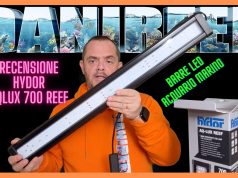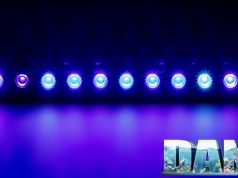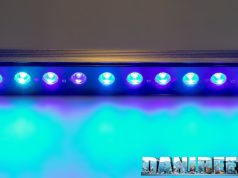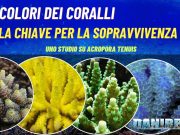
Some days ago we had the opportunity to test thoroughly in our DaniReef LAB the brand new ceiling light Reef Flare PRO L in its two versions: Blue and PRO.
This article is also available in: italiano
We could test even three ceiling lights: Reef Flare PRO L Blue, object of this article, the Reef Flare PRO L, whose article is coming soon, and the Reef Flare Bars 60 Blue.
Some of the pictures will be the same of the other articles. While the data, well, will be very different.
The new Reef Flare are very different from the Reef Flare S that we tested in our DaniReef LAB several months ago. The shell is thinner and it doesn’t have the polished finish anymore. But, most importantly, the LED are way more powerful, and the consumption increased as well. Anyway, they are still controlled through wifi.
We were very curious to see how it would have behaved in our DaniReef LAB. Well, we only have to show you how it went!
Technical characteristics of the Reef Flare PRO L & PRO Blue
The ceiling light is rectangular, only 2,8 cm of height and the base of 47,5×16,2 cm. The LED of Reef Flare are of 7 different types grouped in 7 channels. There aren’t any LED for mooonlight.
| Reef Flare PRO L | Reef Flare PRO L Blue | |
| Length | 47,5 cm | 47,5 cm |
| Width | 16,2 cm | 16,2 cm |
| Height | 2,8 cm | 2,8 cm |
| Power consumption | 240 watt | 240 watt |
| LED configuration | ||
| UV LED- 400 nm | 6 | 12 |
| Violet LED – 420 nm | 6 | 18 |
| Indigo LED – 450 nm | 18 | 12 |
| Blue LED – 470 nm | 18 | 18 |
| Green LED – 530 nm | 3 | 3 |
| Red LED – 660 nm | 3 | 3 |
| White LED – 5700°K | 18 | 6 |
| Total LED | 72 | 72 |

We reported the data of the two ceiling lights because we tried them both! First the Blue and then the PRO. For the same reason, in the following video you’ll see both the ceiling lights and the Blue LED bar of 50 cm. We’re going to make an article of each, but now we’ll start with the Blue which, according to us, is has the most interesting spectrum.
Our video about the Reef Flare Pro L with the partecipation of Marco D’Ambrosi
If you want, turn the Eng subs on! Enjoy!
Construction
The ceiling light is very well built and it’s very solid. As we said, the core is in aluminum, and in the version we have, of almost 50 cm, there are two big fans on top. The controller is integrated and it generates a wifi network to connect to. Obviously is possible to connect the ceiling light to your own home network. Once connected, the ceilight light is controlled through web app for direct link or, once connected to your own network, you can interact with any device with an Internet connection.

The programming
Configuring the ceiling light is very easy. You can manage the colors singularly, as we did for the test, but you can also create infinite curves as it’s seen in the following picture.

Inside the app, here used by smartphone (iPhone), you can see the temperature of the PCB of the ceiling light and the instant power consumption in the adopted configuration.
Channel 1: UV (400 nm)



16 watt for 12 LED, considering 4 watt of consumer electronics, it means having the piloted LED at about 1 watt.
Channel 2: violet (420 nm)



27 watt for 18 LED, considering 4 watt of consumer electronics, it means having the piloted LED at 1,4 watt.
Channel 3: indigo (450nm)



45 watt for 12 LED, considering 4 watt of consumer electronics, it means having the piloted LED at 3,4 watt.
Channel 4: blue (470 nm)



48 watt for 18 LED, considering 4 watt of consumer electronics, it means having the piloted LED at 2,4 watt.
Channel 5: green (530 nm)



14,5 watt for 3 LED, considering 4 watt of consumer electronics, it means having the piloted LED at 3,8 watt.
Channel 6: red (660 nm)



11,5 watt for 3 LED, considering 4 watt of consumer electronics, it means having the piloted LED at 2,8 watt.
Channel 7: white (5.700°K)



27 watt for 6 LED, considering 4 watt of consumer electronics, it means having the piloted LED at 3,8 watt.
The final result

The values we detected, and our working method called DaniReef LAB are on page two.















